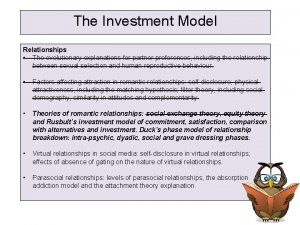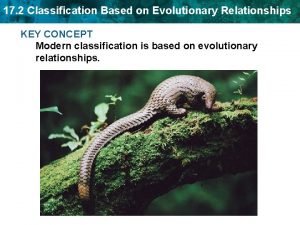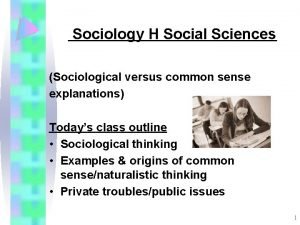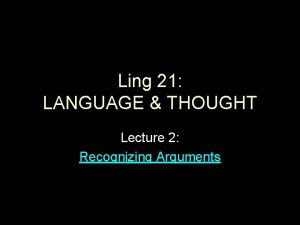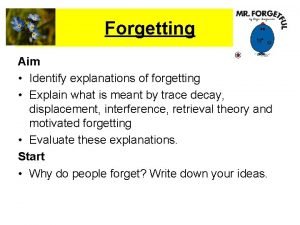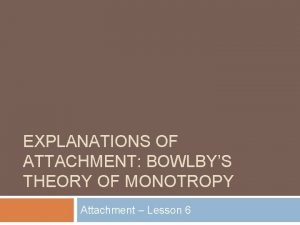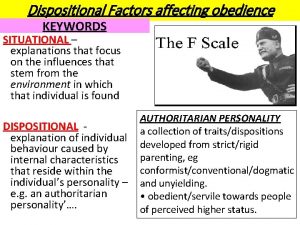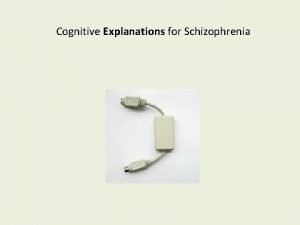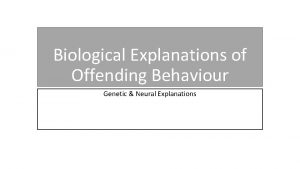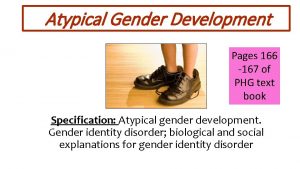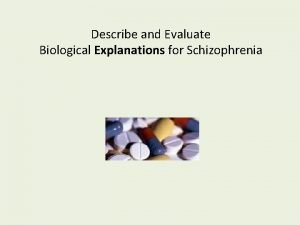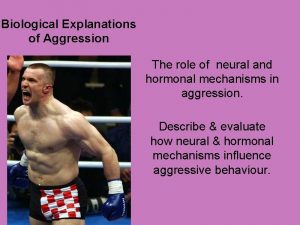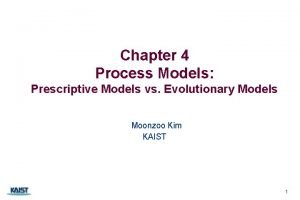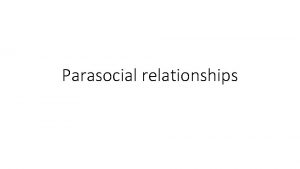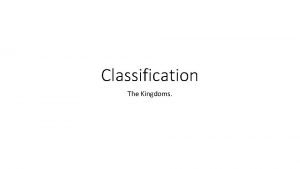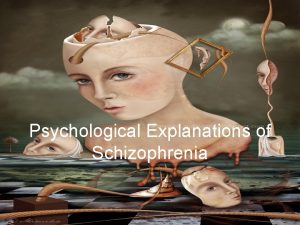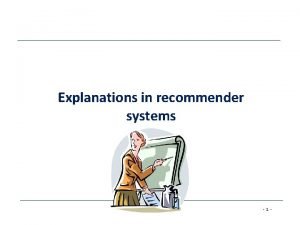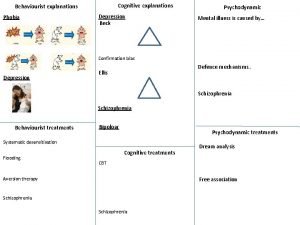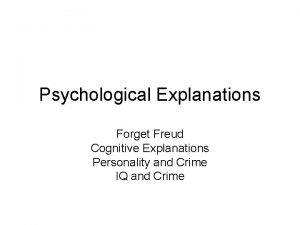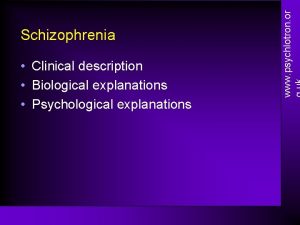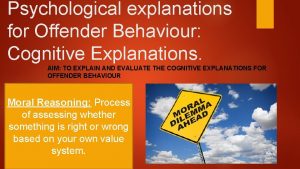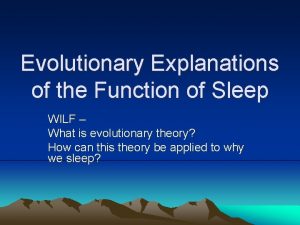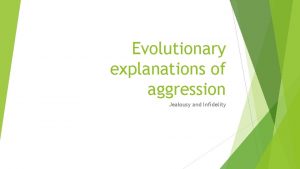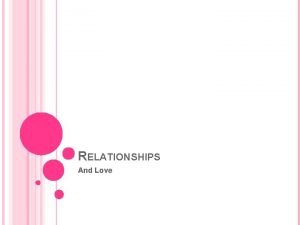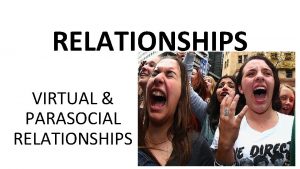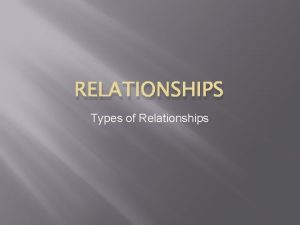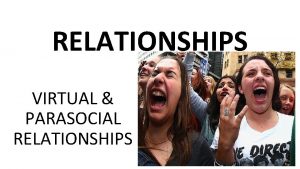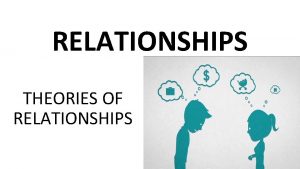The Investment Model Relationships The evolutionary explanations for


























- Slides: 26

The Investment Model Relationships • The evolutionary explanations for partner preferences, including the relationship between sexual selection and human reproductive behaviour. • Factors affecting attraction in romantic relationships: self-disclosure; physical attractiveness, including the matching hypothesis; filter theory, including social demography, similarity in attitudes and complementarity. • Theories of romantic relationships: social exchange theory, equity theory and Rusbult’s investment model of commitment, satisfaction, comparison with alternatives and investment. Duck’s phase model of relationship breakdown: intra-psychic, dyadic, social and grave dressing phases. • Virtual relationships in social media: self-disclosure in virtual relationships; effects of absence of gating on the nature of virtual relationships. • Parasocial relationships: levels of parasocial relationships, the absorption addiction model and the attachment theory explanation.

When you come in… Relationships lucky dip Define the key word or phrase that you have chosen, on the mini whiteboards.

Theories of romantic relationships: Rusbult’s investment model What the spec says: Theories of romantic relationships: Resbult’s Investment Model Describe the main features of Resbult’s model of romantic relationships Explain how relationships form, are maintained, and breakdown according to Resbult’s model Evaluate evidence to support and contradict Resbult’s model

“The glue that holds COMMITMENT our relationships together” What is the ‘glue’ that holds our relationship together?

Investment model of relationships Rusbult (1983) • Suggests that the maintenance of a relationship is determined by commitment. • In this context commitment refers to the likelihood that the relationship will persist. • Commitment can be strengthened by: –Satisfaction –Investment • Commitment is weakened by: –Presence of alternatives to the relationship Just like SET and ET this is an ECONOMIC theory

Misleading • The name of the model is a bit misleading • Remember Investment is only one part of this model!! But it’s so called as its the only part that researchers hadn’t considered previously, so her contribution to the model

Investment is anything that a person puts into a relationship that will be lost if it ends. Intrinsic Investments: Time , personal information – ie self disclosure IE PUT DIRECTLY IN Extrinsic Investments: Shared things that may be lost: Shared pet, network of friends, children

Quality of alternatives • Attractive alternative = they may leave the relationship. • No alternative exists = they maintain the relationship. (Increases satisfaction) • However, sometimes having no relationship is a more attractive alternative than being in an unsatisfactory one.

The Investment Model of Relationships (Rusbult, 1983) Rusbult was interested in studying the factors that contributed to a committed relationship versus relationship breakdown. 3 concepts influence commitment; • Satisfaction • Quality of Alternatives • Investment

Satisfaction • Outcome of relationship (Rewards – C) surpasses Comparison Level = SATISFACTION Notice any of this terminology? Rusbult used alot of SET in her model.

The Investment Model of Relationships (Rusbult, 1983) Satisfaction – If outcomes surpass the comparison level ind’s are satisfied, if not they are dissatisfied. Quality of Alternatives – We may continue a better relationship because there are no better options. Investment – anything an individual puts into a relationship that will be lost if they leave it.

In your pairs, use the investment model to explain why Christy continues the relationships.

Evaluation of The Investment Model Research Support To test this hypothesis, Rusbult asked college students in heterosexual relationships to complete questionnaires over a 7 month period. They kept notes about how satisfactory their relationship was, how it compared with others and how much they had invested in it. Students also noted how committed they felt to the relationship and whether it had ended.

The Investment Model of Relationships (Rusbult, 1983) 1. What do the results in the table suggest about Commitment? 2. What factors are important in commitment to a relationship?

The Investment Model Investment Size Rusbult suggested that the CL and the CLalt from the SET are not enough to explain commitment to a relationship. Rusbult (1983) found that when people were deciding whether to end a relationship, not only did they weigh up the rewards and the costs of the relationship and possible alternatives available to them, but they also considered how much they had invested in the relationship. She defines investment as ‘anything a person puts into a relationship that will be lost if they leave it’. Investments can be financial (like a house), temporal (such as time spend together) or emotional (such as in the welfare of the children). Investments can thus has a ‘sunk cost’ effect, where a person stays in a relationship simply because they have already invested significantly in it.

The Investment Model of Relationships

The Investment Model of Relationships (Le & Agnew, 2003) • A Meta-Analysis of research into Rusbults Model. Task • Read the summary on page 90 • Summarise the Aim, Procedure, Findings, Conclusions.

Evaluation of The Investment Model Explaining Abusive Relationships The investment model is thought to be particularly valid and useful explanation of relationships involving Intimate Partner Violence (IPV). Rusbult and Martz (1995) applied the investment model to abusive relationships. They asked women living in refuges why they had stayed with their abusive partners instead of leaving them as soon as the abuse began. As predicted by the model, women had felt the greatest commitment to their relationship when their economic alternatives were poor and their investment was great.


Rusbult’s questions 1. how do people work out how satisfying a relationship is according to this model? 2. Of the three factors that determine commitment in relationships, two are similar to the assumptions of social exchange theory – which are they and what do they equate to? 3. What did Rusbult say were the two types of investment? Give examples of each. 4. Why did Rusbult think that the distinction between commitment and satisfaction was important? 5. One of the strengths of theory is that it can explain ‘intimate partner violence’. Outline how it does this, with reference to relevant research.

Worksheet Answers • Conducted a meta–analysis of Rusbult's Investment Model of commitment. • Across 52 studies, including 60 independent samples and 11, 582 participants, satisfaction with, alternatives to, and investments in a relationship each correlated significantly with commitment to that relationship. • Moreover, these three variables collectively accounted for nearly two–thirds of the variance in commitment. • Commitment, in turn, was found to be a significant predictor of relationship breakup. • Support for the model was obtained in predicting commitment in both relational domains (e. g. , commitment to a romantic partnership) and nonrelational domains (e. g. , commitment to one's job), but was significantly stronger in relational domains. • Additional moderator analyses suggested that the associations between commitment and its theorized bases vary minimally as a function of demographic (e. g. , ethnicity) or relational (e. g. , duration) factors.

Oversimplifies investment

Evaluation of The Investment Model Methodology Much of the evidence supporting the Investment model relies on self-report measures such as interviews and questionnaires. Generally these methods would be seen as a weakness but in this instance they are the most appropriate methods to use because it’s not the objective reality of factors that matter. What matters is the individual partner’s perception of these factors. It is your belief that you have made a big investment in your current relationship, or your belief that you have no attractive alternatives, that will influence your commitment. Whether the belief matches the objective reality of the situation is really neither not there.

Evaluation of The Investment Model Based on Correlational Research Strong correlations have been found between all the important factors predicted by the investment model. However, even the strongest correlation is no evidence of causation. Most studies don’t actually allow us to conclude that any of the factors actually cause commitment in a relationship. It could be the more committed you feel towards your partner, the more investment you are willing to make in the relationship, so the direction of causality may be the reverse of that predicted by the model.


Task Have a go at the ‘Apply it’ questions on pages 18 and 19 of your workbook.
 The investment model of relationships
The investment model of relationships Classification is based on evolutionary relationships
Classification is based on evolutionary relationships Classification based on evolutionary relationships
Classification based on evolutionary relationships Fixed investment and inventory investment
Fixed investment and inventory investment Common sense and sociological explanations
Common sense and sociological explanations Premise indicators
Premise indicators Motivational forgetting
Motivational forgetting Monotropy attachment theory
Monotropy attachment theory Outline two explanations for obedience
Outline two explanations for obedience Cognitive explanations of schizophrenia
Cognitive explanations of schizophrenia Dust bowl migration map
Dust bowl migration map Political cartoons
Political cartoons Evaluate the atavistic form explanation for offending
Evaluate the atavistic form explanation for offending Neural explanations of offending behaviour
Neural explanations of offending behaviour Gender dysphoria biological explanations
Gender dysphoria biological explanations Diathesis stress model
Diathesis stress model Biological explanations of aggression
Biological explanations of aggression Difference between prescriptive and evolutionary model
Difference between prescriptive and evolutionary model Fspos
Fspos Typiska novell drag
Typiska novell drag Nationell inriktning för artificiell intelligens
Nationell inriktning för artificiell intelligens Returpilarna
Returpilarna Varför kallas perioden 1918-1939 för mellankrigstiden?
Varför kallas perioden 1918-1939 för mellankrigstiden? En lathund för arbete med kontinuitetshantering
En lathund för arbete med kontinuitetshantering Underlag för särskild löneskatt på pensionskostnader
Underlag för särskild löneskatt på pensionskostnader Tidbok yrkesförare
Tidbok yrkesförare Sura för anatom
Sura för anatom
